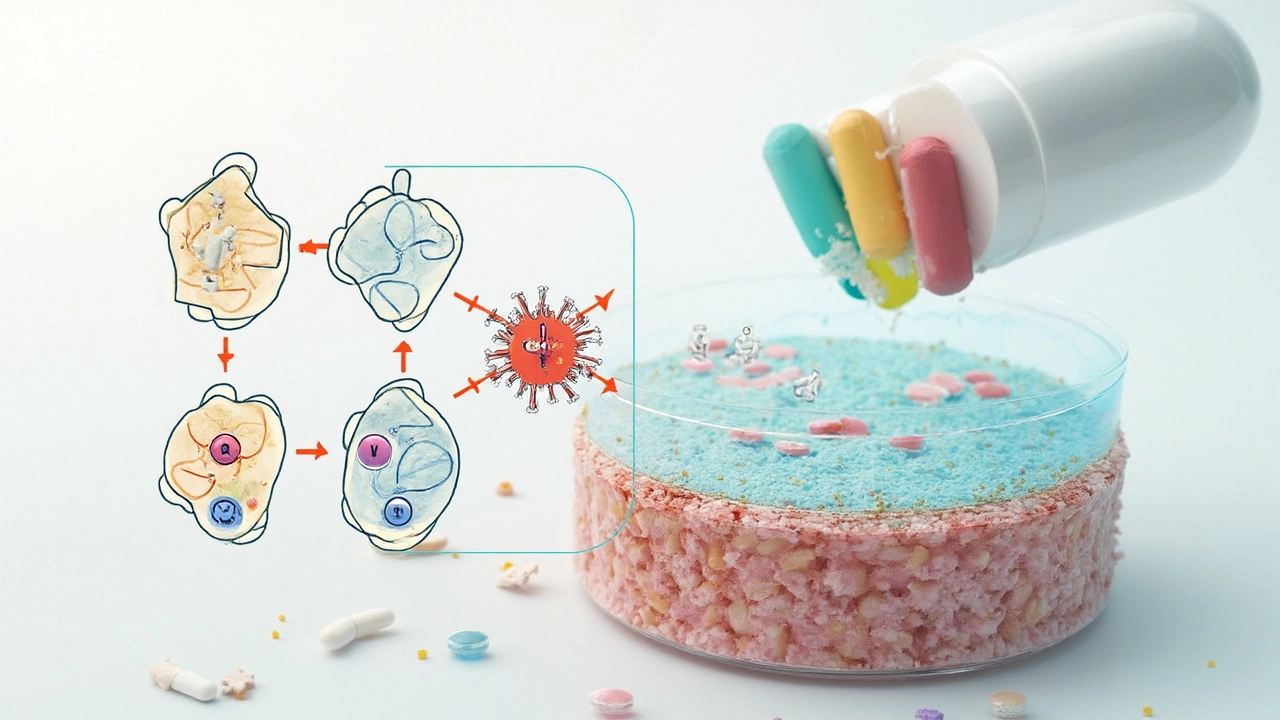Ask anyone who lived through the HIV crisis of the 1980s and 90s about the biggest breakthrough in treatment, and you’ll probably get one word: hope. Back then, HIV was often a looming death sentence. Medicines were messy, side effects were brutal, and keeping up with complex schedules felt impossible. But around the late 1990s, something remarkable happened. Scientists figured out a clever way to use a little helper drug—ritonavir—to supercharge other HIV medicines, specifically a class called protease inhibitors. That move turned a battle into a winnable war for thousands of people.
Why Protease Inhibitors Matter in the HIV Fight
Imagine HIV as a sneaky lock-picker, breaking into our immune system cells and using them as factories. Protease inhibitors, or PIs for short, are like padlocks that stop the virus from cutting up big protein chains into smaller pieces it needs to make more copies of itself. Drugs like lopinavir, atazanavir, and darunavir—some of the heavy hitters—are all members of this PI club. When used right, protease inhibitors slam the door in the virus’s face.
Problem is, PIs aren’t always easy to tame. On their own, the liver gets busy breaking them down so fast you might need to pop pills several times a day just to keep enough drug around. That’s not just inconvenient, it’s a recipe for missing doses and letting the virus regroup. Stick to the schedule, or you risk resistance—where HIV gets smart and dodges the drugs next time.
Protease inhibitors have a long track record. Since the first one, saquinavir, was licensed in 1995, studies have consistently shown they’re effective at getting viral loads down to “undetectable”—so low you can’t pass HIV on sexually, which the U=U (Undetectable = Untransmittable) campaign shouts from the rooftops. Still, to really get the best from these medicines, they need a little help staying in your system at just the right level.
Ritonavir: From Standalone Drug to Superstar Booster
Now, here’s where the magic happens. Early on, ritonavir was just another PI, but researchers spotted something fascinating in lab tests. Ritonavir is a powerful inhibitor of an enzyme called CYP3A4, the main “garbage disposal” for lots of medicines, including other PIs. Give someone a small dose of ritonavir alongside their main PI, and you suddenly block CYP3A4’s breakdown action. Result? The main PI sticks around in the blood much longer and at stronger levels.
This approach quickly changed the HIV landscape. Suddenly, dosing schedules shrunk from handfuls of pills several times a day to far simpler regimens—sometimes just one or two pills daily. For real people, this meant missing fewer doses and having a much higher chance of long-term viral suppression. The side effects of ritonavir in high doses could be harsh, but the “boosted” doses are much lower—usually 100 or 200mg a day—so most people can handle them fine.
The switch to ritonavir boosting is no small story. By 2003, over 70% of PI prescriptions included ritonavir as a booster. Clinics in places like London and San Francisco quickly saw viral suppression rates climb, according to studies in the Journal of Infectious Diseases and Clinical Infectious Diseases. For the NHS, simplified regimens meant fewer people coming back with drug resistance, slashing long-term care costs.
For doctors and nurses, shorter regimens meant more time to focus on other patient needs. For people living with HIV, it meant more normal life. Much less pill fatigue. And something most of us might take for granted: hope that treatment could actually work for the long haul.

How Ritonavir Boosting Really Works: The Science Bit
Here’s the nitty gritty for anyone who likes the science. Our liver is packed with enzymes like CYP3A4, which break down many drugs, including all major PIs. Ritonavir not only blocks CYP3A4 but also hampers P-glycoprotein, a transporter protein that pushes drugs back out of cells. So with ritonavir around, protease inhibitors stay where they’re supposed to, circulating at higher and steady levels.
Check out the numbers in this real-life data:
| Protease Inhibitor | Half-life Without Ritonavir | Half-life With Ritonavir |
|---|---|---|
| Lopinavir | 5-6 hours | 14 hours |
| Atazanavir | 6-7 hours | 12 hours |
| Darunavir | 7 hours | 15 hours |
That’s a game changer. Boosting means people can take their medication once or twice a day without rollercoaster blood levels or worrying if they’re protected.
The other benefit? Lower doses—so less chance for gut trouble, high cholesterol, or that classic PI fat redistribution (remember the “buffalo hump” and “moon face” issues talked about in the 2000s?). By helping PIs work smarter, not harder, ritonavir lets people stick with therapy for years instead of months.
What about interactions? Here’s where folks need to double-check with their doctor or pharmacist. The same enzyme-blocking power that helps your HIV treatment can accidentally boost other meds too—things like statins, steroids, or even warfarin. This means you’ve got to be up-front about every medicine or supplement you take, not just your HIV pills. It might sound like a headache, but the extra planning keeps things safe.
Everyday Realities: Tips for Sticking with Boosted HIV Therapy
Every doctor loves a tidy dashed-line graph, but real life’s messier. Staying on a boosted PI regimen takes a bit of planning, especially at first. Pills need to be taken at the right times, often with food. Tablets like darunavir/ritonavir work best with a meal—going hungry might knock down drug absorption, so don’t skimp on breakfast or dinner.
- Traveling or eating out? Keep a spare dose in your bag, and set reminders on your phone.
- Feeling sick? Talk to your clinic if vomiting lasts more than a few hours—it can mess with levels.
- Side effects? Most folks tolerate low-dose ritonavir well, but some get tummy upset, taste changes, or occasional diarrhea. If things don’t settle after a week or two, call for advice.
- Mental health matters. Keeping on top of lifelong meds can be mentally draining. If you’re feeling anxious or overwhelmed, some clinics offer peer support groups. Sometimes, just chatting with someone who’s “been there” makes all the difference.
- Use a pillbox or app. Even the most organized person forgets now and then, especially if routines change. Something as simple as a seven-day pill organizer works wonders, or there are loads of free apps that remind you when and what to take.
The best bit? Get your blood tests done regularly. Most folks on boosted PIs will check viral load and liver/kidney function every 3-6 months. It’s quick, and catches problems before they snowball. If you see “undetectable” on your results, you’re winning—it means your meds are working, and you’re looking after your health (and everyone else’s, thanks to U=U).

Where Next? Emerging Options and the Future of Boosting
Here’s something wild: Even as new drugs roll out, ritonavir’s booster trick isn’t going away soon. It’s still the gold standard booster for darunavir and some other PIs. That said, researchers never stand still. These days, you might see cobicistat paired with some PIs instead—it’s not an HIV drug, just a pure booster, and has fewer side effects for some people, especially in terms of tummy trouble or cholesterol.
Tablets are getting smarter, too. The rise of “single-tablet regimens” (STRs) means you can take a combo of drugs, including boosters, all in one go. In the UK, several fixed-dose options are now on the NHS, cutting down pill counts even more. Long-acting injectable therapies now coming through the pipeline could make boosting less important for people with stable, undetectable HIV, but we’re not quite there for everyone. High-resistance and complicated cases still need the trusted punch of ritonavir-boosted PIs.
And don’t forget: medicine access is not equal worldwide. In many places, ritonavir boosting allows clinics to run robust HIV programs without skyrocketing costs or complicated monitoring. Some low-income countries rely on the extended action boosted PIs give, letting them stretch drug supplies further and keep more people healthy on fewer resources.
So, here’s the real talk: while ritonavir the booster might sound like an old dog in the fast-moving world of HIV medicine, it’s still pulling its weight. For millions, it means fewer pills, better results, and lives that look and feel a lot more “normal.” That’s a pretty good legacy—one little helper drug that changed the way the world fights HIV, and is still earning its place at the frontline.


Hannah Gorman
July 18, 2025 AT 18:42Honestly, the advent of ritonavir boosting really reshaped the landscape of HIV treatment in ways many of us couldn't have predicted when protease inhibitors were first introduced.
Its mechanism of inhibiting cytochrome P450 3A4 allows for other protease inhibitors to linger longer in the bloodstream, which maximizes efficacy and minimizes the pill burden on patients. But, it’s not all smooth sailing; the interactions and side effects require careful management and patient education.
I worry sometimes that the excitement over its clinical success might overshadow the necessary vigilance about adverse effects and resistance development when used improperly. Still, applying ritonavir boosting has been indispensable for durable viral suppression in many regimens.
It would be really great to see more comprehensive protocols that balance its potent pharmacokinetics with personalized medicine approaches to avoid pitfalls.
Nonetheless, this article does a commendable job breaking down a complex topic into digestible insights, very useful for both clinicians and lay readers.
Aayush Shastri
July 19, 2025 AT 21:12I appreciate this post because it highlights an important advancement in global HIV care.
In countries like India, access to optimized protease inhibitor therapies, including ritonavir boosting, has improved treatment outcomes dramatically, but challenges remain regarding affordability and education around these therapies.
Many patients I’ve encountered benefit greatly once they understand that boosting with ritonavir is what makes the treatment more effective and sustainable by reducing viral load over the long-term.
Still, there are sociocultural barriers that limit uptake and adherence, so sharing clear, research-backed information, like what’s outlined here, is really valuable.
Grateful to see such posts fostering cross-cultural dialogue on improving HIV treatment worldwide.
Olivia Crowe
July 20, 2025 AT 21:12This is absolutely fascinating to learn about! Ritonavir boosting truly feels like a game-changing strategy.
It’s incredible how such a small addition can prolong the action of protease inhibitors and improve the patients’ quality of life, allowing fewer pills and less frequent dosing.
So many people living with HIV can benefit from this, and it gives hope that treatment can become more manageable and less disruptive.
I wish more awareness campaigns highlighted this approach, since knowledge empowers everyone affected.
Thank you for breaking down the science behind it in such an understandable way — it really helps demystify what can often be a daunting topic.
Abdulraheem yahya
July 21, 2025 AT 21:12Seeing the differences in clinical outcomes due to ritonavir boosting in various regions is quite eye-opening.
This kind of pharmacological innovation not only extends drug efficacy, but it also helps reduce the risk of resistance by maintaining therapeutic drug levels.
Of course, it requires health systems to ensure careful drug interaction monitoring and patient follow-up. But the benefits outweigh such challenges.
I’m reminded of some clinics I've visited where patient outcomes improved significantly after ritonavir-boosted protease inhibitors were introduced.
Scaling this knowledge globally remains essential for sustained viral suppression and the eventual goal of ending the HIV epidemic.
Preeti Sharma
July 22, 2025 AT 23:58While the science is undoubtedly impressive, I find it a bit unsettling how reliant treatment has become on combining drugs like ritonavir, which essentially acts as a pharmaceutical enhancer rather than a stand-alone therapy.
One wonders if this model just masks symptoms or extends drug half-life without addressing broader issues such as immune system restoration or viral reservoir clearing.
Also, the complexity of drug-drug interactions associated with boosting raises philosophical questions about whether we're complicating treatment unnecessarily.
Is boosting more beneficial in the long run or does it create dependencies that could limit future therapeutic options?
Nevertheless, I must concede it's a clever pharmacological strategy, but it requires contemplation on the bigger picture of HIV management.
Ted G
July 24, 2025 AT 02:45Okay, but has anyone really thought about what ritonavir boosting does behind the scenes? It's known to mess with liver enzymes, sure, but what if that opens doors for who knows what in the body?
Like, is the ‘boosting’ just a convenient way to keep pharmaceutical companies’ profits rolling by making people dependent on these meds?
The way it magnifies the effectiveness of other drugs definitely sounds like it could also amplify negative effects not fully tracked in studies.
We should be cautious and question what long-term suppression means for immune health beyond just viral load numbers.
I’m not dismissing the science, but skepticism keeps us safer, don’t you think?
Miriam Bresticker
July 25, 2025 AT 02:45ThIs iS sO inTeReStInG!!! 😍 RitOnAvIr bOoStInG is like the ultimate combo move in the HIV therapy game, making sure the drugs stick around longer and fight the viral guys HARD! 💊🔥
It’s super cool how one drug can be the sidekick to another, making everything just work better together. Science is AMAZING! 😄
Also, the stories from clinics add some real-life spice and ❤️ to all this medical jazz.
I can't wait to see how this strategy keeps evolving and helping peeps live their best lives! 🌈✨
Claire Willett
July 26, 2025 AT 02:45Ritonavir boosting yields a marked enhancement in protease inhibitor pharmacodynamics, undoubtedly pivotal in contemporary HIV management.
Its inhibition of CYP3A4 elevates plasma concentrations of companion antivirals, thereby extending half-life and reducing daily dosages required.
Such pharmacokinetic modulation permits superior viral suppression metrics and enhances patient adherence profiles.
However, stringent vigilance over polypharmacy and possible adverse drug interactions remains paramount.
Overall, its strategic application underscores a sophisticated pharmacological synergy indispensable for optimizing antiretroviral therapy.
Keli Richards
July 27, 2025 AT 02:45This post provides a really accessible overview of a concept that’s often framed too clinically or technically for general audiences.
I appreciate how it distills the science without being too simplistic, making it easier for people affected by HIV—and even caregivers—to understand why ritonavir boosting matters.
From the perspective of someone deeply invested in patient-centered care, anything that can make treatment regimens more tolerable and efficacious is crucial.
I also like the practical tips and stories; they bring humanity to what sometimes feels like purely biochemical discussions.
Great job highlighting the balance between research and real-world application here.
Ravikumar Padala
July 28, 2025 AT 02:45Eh, I mean, ritonavir boosting is fine, I guess, but lots of these meds come with baggage, and long-winded explanations don’t always mean better outcomes in reality.
Patients still face side effects, compliance issues, and often the cost is prohibitive in many settings.
Sure, boosting helps, but it might not be the miracle solution some think it is.
Hard to keep excited when the field moves slowly and the problems on the ground aren't always addressed by these pharmacological tweaks.
Still, informative post if you’re really interested in how the drugs work.
Anna Marie
July 29, 2025 AT 02:45Thank you everyone for the thoughtful and diverse insights on ritonavir boosting. I’m so glad this sparked such a rich conversation!
It’s clear that while ritonavir boosting offers critical advances in HIV therapy, patient-centered implementation and awareness about drug interactions are essential.
Your points about affordability, access, and skepticism highlight the challenges we must navigate alongside the scientific progress.
We strive to balance the potent benefits with careful monitoring and equitable healthcare delivery.
Looking forward to continuing this dialogue and supporting real-world applications that truly help people.